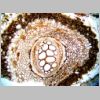The tree fern PsaroniusPsaronius is an extinct tree fern that lived during the Late Carboniferous and the Permian. It was most widespread during the youngest Carboniferous (Stephanian) and the Early Permian (Rotliegend). It could grow up to 10 or 15 meters high and wore a crown of Pecopteris leaves. The large number of Pecopteris fossils found in the Stephanian and the Lower Permian are an indication of the frequent occurrence of Psaronius.
Gymnospermous and angiospermous trees have secondary growth by which
they can form strong woody trunks. Tree ferns, Psaronius included,
don't have secondary growth. They have developed another way to form a stable
(false) trunk, as follows: From the central strand of Psaronius also leaf bases split off. These were relatively thick because the leaves attained a length of 2 to 3 meters. The upper part of the stem didn't have a root mantle (yet) and below the leafy crown the scars of fallen-off leaves were visible. In lower parts of the stem these leaf scars were hidden by the root mantle. |
| In the region of the city of Chemnitz (Sachsen, Germany) many silicified
trunks of Psaronius (and other tree species) are found as a consequence
of a gigantic volcanic eruption in the Early Permian, about 290 million years
ago. Especially the silicified root mantles yield, after sawing and polishing,
beautiful images because of the fact that the woody kernel of the rootlets
is star-shaped. That's why these fossils are called
Staarsteine, meaning star stones. The cellular
structure outside the wood kernels has not been preserved in most cases and
the room has been filled up with agate.
Click the photo for more detail and for the star show. |
| Madensteine Research on coal balls from the US has revealed that the leaves of Psaronius are of the Pecopteris-type. Petioles with attached fronds have been found. Many of the leaflets still bear the sporangia. These are fused in a characteristic way to synangia. Pecopteris-leaves with such synangia are called Scolecopteris. At a couple of places in Sachsen, near Dresden and near Chemnitz, pieces of silicified rock are found containing Pecopteris/Scolecopteris leaflets. They are called 'Madensteine' because people thought them to be full of fossil maggots (Maden). The material of these Madensteine is called Hornstein or chert.
|
Early species of Psaronius are known from the Namurian of Scotland
and the Lower Pennsylvanian of Illinois. In the Westfalian A and B this genus
was still relatively rare but in the Westfalian C and D it became more
widespread. In the Stephanian and the Early Permian Psaronius was
most widely spread.
The various species lived in very diverse environments: wet lowlands, peat
forming wet woodland, but also on periodically dry grounds.
Psaronius disappeared only later in the Permian, when the climate
became very dry and hot in many places .
 Another
interesting fact is that in and on the root mantle many epiphytic ferns were
growing. Also liana-like ferns and seedferns were climbing up along the
Psaronius trunks. Stems have been found with up to eight climbing
axes of one plant. Often the rootlets of these epiphytes are found among
the rootlets of Psaronius. They are strikingly different in structure
from the Psaronius roots.
Another
interesting fact is that in and on the root mantle many epiphytic ferns were
growing. Also liana-like ferns and seedferns were climbing up along the
Psaronius trunks. Stems have been found with up to eight climbing
axes of one plant. Often the rootlets of these epiphytes are found among
the rootlets of Psaronius. They are strikingly different in structure
from the Psaronius roots.